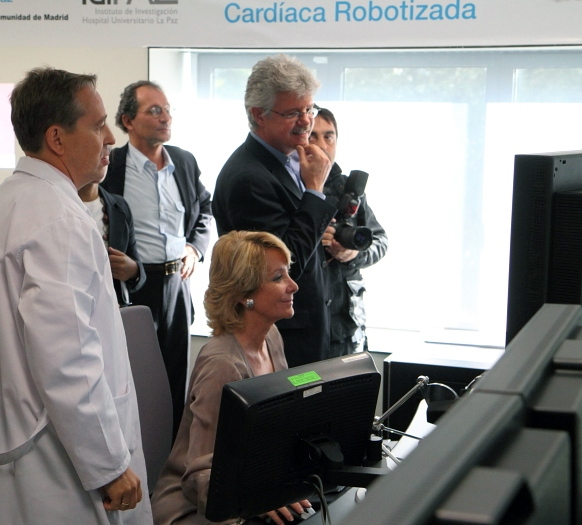
President of Madrid Inaugerates Magnetecs EP Lab in Spain
Inglewood, CA – Magnetecs Corporation, a designer and manufacturer of robotic systems for minimally invasive surgical procedures, today reported the inauguration of the electrophysiology lab at Hospital General Universitario La Paz in Madrid, Spain, equipped with the Company’s CGCI Catheter Guidance Control and Imaging (CGCI) system.

Doña Esperanza Aguirre y Gil de Biedma, Countess of Murillo, Grandee of Spain, and the current President of Madrid, with Josh Shachar, CEO and CTO of Magnetecs Corporation at opening of Magnetecs EP lab in Hospital General Universitario La Paz
The opening ceremonies included a keynote address by Doña Esperanza Aguirre y Gil de Biedma, Countess of Murillo, Grandee of Spain, who is President of Madrid, President of Madrid’s People’s Party and the first female politician in Spain to have held the offices of President of the Senate and Minister of Education and Culture. “We are proud that La Paz hospital is the first in the world to have this advanced system for treating heart conditions,” said President Aguirre. “The cardiology department of La Paz Hospital is a pioneer in the treatment of complex arrhythmias and other diseases of the heart. This new electrophysiology laboratory is an important milestone in the research and treatment of heart disease.”
With President Aguirre at the inauguration of the electrophysiology laboratory was Javier Fernandez-Lasquetty, Minister of Health. In addition to dignitaries from Spain the ceremonies were conducted by Dr. Jose Merino, Director of the Arrhythmia & Electrophysiology Research Unit of the hospital, and Josh Shachar, Chief Executive Officer and Chief Technology Officer of Magnetecs Corporation.
Human studies of the CGCI system are scheduled to begin on October 7, 2010. The Principal Investigator for the studies is Dr. Vivek Reddy, Professor of Medicine and Director, Cardiac Arrhythmia Service, Mount Sinai School of Medicine, in New York City. The studies will also be conducted by Dr. Eli Gang, Chief Medical Officer of Magnetecs, Clinical Professor of Medicine, Geffen School of Medicine at UCLA, and has served as Director of the Clinical Electrophysiology Laboratory at Cedars-Sinai Medical Center in Los Angeles.
The initial study will consist of 20 patients in which a highly detailed map of the heart will be created using the CGCI magnetically guided catheter. The mapping study is expected to be completed by the end of 2010, and will be followed by a study of 40 patients in which mapping and ablation procedures will be conducted using the CGCI system. The second study is expected to be completed in the second quarter of 2011.
CGCI HUMAN TRIALS IN MADRID FOR CE MARK CERTIFICATION
Dr. Merino and team watch Presiden Aguirre at CGCI Control Console

Dr. Merino and team watch Presiden Aguirre at CGCI Control Console
CGCI uses eight electromagnets in a unique configuration to intelligently guide a magnetically-tipped catheter, enabling a physician to precisely and consistently control surgical tools in highly dynamic or previously inaccessible environments while enhancing both the physician’s dexterity and the patient’s safety. The first study in mapping of the heart is a diagnostic procedure that is performed for patients who have arrhythmia, or irregular heart beat. Magnetecs expects this study to lead to a CE Mark application for commercialization in Europe planned for the first half of 2011. Additional human studies for ablation are expected to lead to approval of the CGCI system for therapeutic procedures used to correct heart arrhythmia.
PLANNED CGCI INSTALLATIONS IN LONDON, NEW YORK CITY AND PRAGUE
Additional installations in Europe and the US will support the Company’s program to receive FDA 510(k) certification. Magnetecs is currently in the initial stages of planning human studies in the US at Mount Sinai Medical Center in New York City under the direction of Dr. Reddy and Dr. Andre d’Avila, and in the UK at St. Mary’s Hospital in London under the direction of Dr. Nicholas Peters and Dr. Wyn Davies. CGCI installations and studies are also currently being planned at Na Homolce Hospital in Prague, Czech Republic, and at Cedars-Sinai Medical Center in Los Angeles, California.
